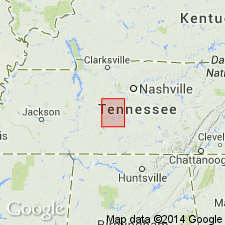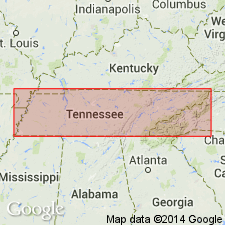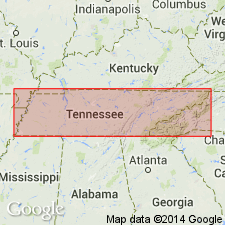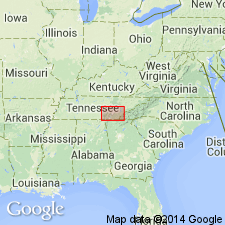
- Usage in publication:
-
- Bigby limestone*
- Modifications:
-
- Named
- Dominant lithology:
-
- Limestone
- AAPG geologic province:
-
- Cincinnati arch
Summary:
Bigby limestone named in this report for exposures on Big Bigby Creek, Maury Co., central TN. Unit is generally nearly uniform, semi-oolitic or granular crystalline, laminated, phosphatic limestone of gray or bluish color. Upper part often shaly or arenaceous. Lower part frequently having beds of shale but never sandy. Thickness 30 to 100 ft. Of Trenton age. Unconformably underlies Catheys formation and overlies Hermitage formation, both of Trenton age.
Source: GNU records (USGS DDS-6; Reston GNULEX).

- Usage in publication:
-
- Bigby limestone*
- Modifications:
-
- Revised
- AAPG geologic province:
-
- Cincinnati arch
Summary:
Pg. 34, and C. Butts, 1926 (Alabama Geol. Survey Spec. Rpt., no. 14, chart opp. p. 80). Bigby limestone. Shows Cannon limestone of Tennessee as underlying Catheys limestone and overlying Bigby limestone. This is present [ca. 1938] accepted definition of Bigby limestone, which lies unconformably on Hermitage formation.
Source: US geologic names lexicon (USGS Bull. 896, p. 182).

- Usage in publication:
-
- Bigby-Cannon limestone
- Modifications:
-
- Revised
- AAPG geologic province:
-
- Cincinnati arch
Summary:
Pg. 2 (fig. 1), 80, 107-121. Bigby limestone grades laterally into Cannon limestone. The two are contemporary facies of unit here termed Bigby-Cannon limestone which overlies Hermitage formation and underlies Catheys formation. All included in Nashville group. [Age is Middle Ordovician.]
Source: US geologic names lexicon (USGS Bull. 1200, p. 329).

- Usage in publication:
-
- Bigby Limestone*
- Modifications:
-
- Overview
- AAPG geologic province:
-
- Cincinnati arch
Summary:
Nashville Group, consisting of Catheys Formation, Bigby and Cannon Limestones, and Hermitage Formation, is mapped undivided. Age of Bigby is Middle Ordovician. Bigby correlates with Cannon.
Source: GNU records (USGS DDS-6; Reston GNULEX).

- Usage in publication:
-
- Bigby Limestone*
- Modifications:
-
- Age modified
- AAPG geologic province:
-
- Cincinnati arch
Summary:
Bigby Limestone is Champlainian (Kirkfieldian and Shermanian) in age. Shown undivided with Cannon Limestone.
Source: GNU records (USGS DDS-6; Reston GNULEX).
For more information, please contact Nancy Stamm, Geologic Names Committee Secretary.
Asterisk (*) indicates published by U.S. Geological Survey authors.
"No current usage" (†) implies that a name has been abandoned or has fallen into disuse. Former usage and, if known, replacement name given in parentheses ( ).
Slash (/) indicates name conflicts with nomenclatural guidelines (CSN, 1933; ACSN, 1961, 1970; NACSN, 1983, 2005, 2021). May be explained within brackets ([ ]).

